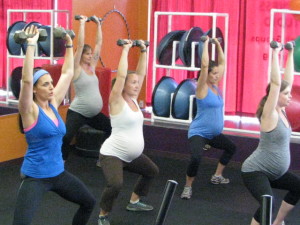Back pain and pelvic pain are seemingly synonymous with pregnancy. Once baby arrives, your pelvis may ache, your pelvic floor may be fatigued and healing and you will likely feel somewhat disconnected from your core as recovery begins. Staying strong throughout pregnancy is vital…and partaking in safe, appropriate postpartum training is equally important.
Symphysis Pubis Dysfunction, referred to as Pelvic Girdle Pain (PGP) describes pain in the joints of your pelvis. These joints include the symphysis pubis joint (SPJ) at the very front of your pelvis (ie your pubic bone) and/or the sacro-iliac joints (SIJ) at the back (ie where the back of your pelvis joins on to your spine).
If you have PGP, you’ll feel pain across the front or back of the pelvis, which can range from mild discomfort to severe pain.
If you’re experiencing any pelvic/lower back pain, I’d strongly suggest you be referred to a Pre/Postnatal trained Physiotherapist, Chiropractor or Osteopath who will assess the position and symmetry of movement of your pelvic joints.
The muscles that need to be strengthened to improve stability are the core muscles, and the pelvic floor, and in some cases, it’s your glutes/hip stabilizing muscles which need attention too.

Functional movements with added resistance of free weights–always challenging but modifiable and individualized!
Here are some tips:
DO:
- Be as active as possible within pain limits and avoid activities that make the pain worse
- Ask for help! Many household chores and everyday activities may be difficult or painful–accept help wherever you can get it.
- Rest and relax when you can. Sitting on a large exercise ball is often more comfortable than a chair and easier to get up from.
- Sit down to get dressed/undressed
- Wear flat supportive shoes
- Try to keep your knees together when moving out of the car. A plastic bag on the seat may help you to swivel.
- Sleep on your side with a pillow between your legs
- Try different ways of turning in bed, ie: turning under or turning over with your knees together
- Roll in/out of bed keeping your knees together
- Take the stairs one at a time
- Use a small rucksack to carry your stuff around – this leaves your hands free to hang onto something for support
AVOID:
- Standing on one leg
- Bending and twisting to lift something
- Carrying an object on one hip
- Sitting with your legs crossed
- Sitting or standing for long periods
- Lifting heavy objects (shopping bags, wet washing, vacuum cleaners)
- Vacuuming
- Carrying anything in only one hand
Of course not all of these activities CAN realistically be avoided –but just try to get as much help as you can, go slowly and most importantly, think before you move.
Here’s a quick read from Heraspere regarding the importance of seeing a physiotherapist after delivery! It can be life-changing along the path to recovery.
[hr]You can work with me one-one-one via Skype or in-person. Visit www.bodiesforbirth.com to learn more!
If you found this helpful, why not share?! Thank you!
________________
Written in collaboration with Claire Mockridge, www.clairemockridge.com
Claire Mockridge is a qualified and experienced Personal Trainer, Fitness Instructor and Pilates Teacher with a passion for fitness and wellbeing. Teaching general exercise and Pilates classes in West Bridgford, Nottingham, Claire has a specialism in pregnant and postnatal fitness.
See more at: http:www.clairemockridge.com

